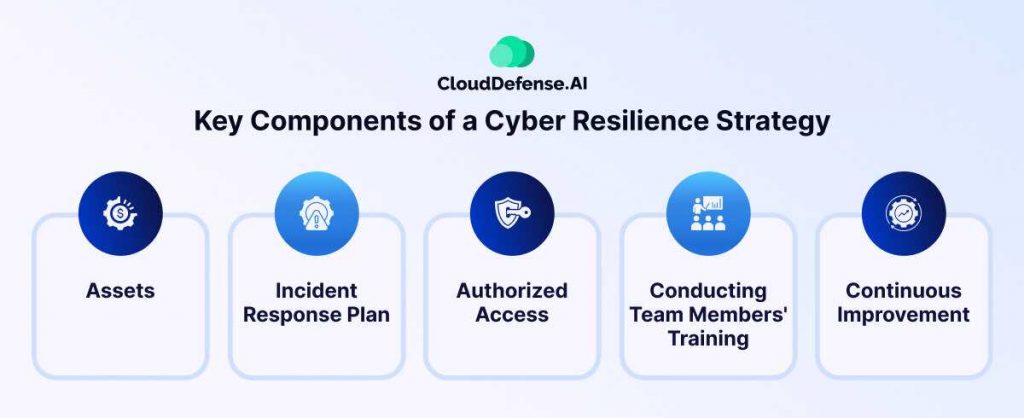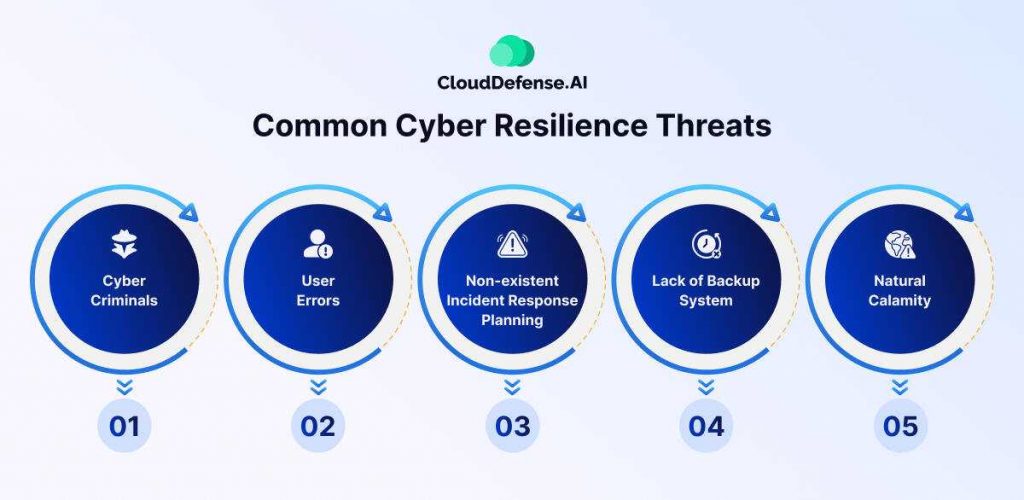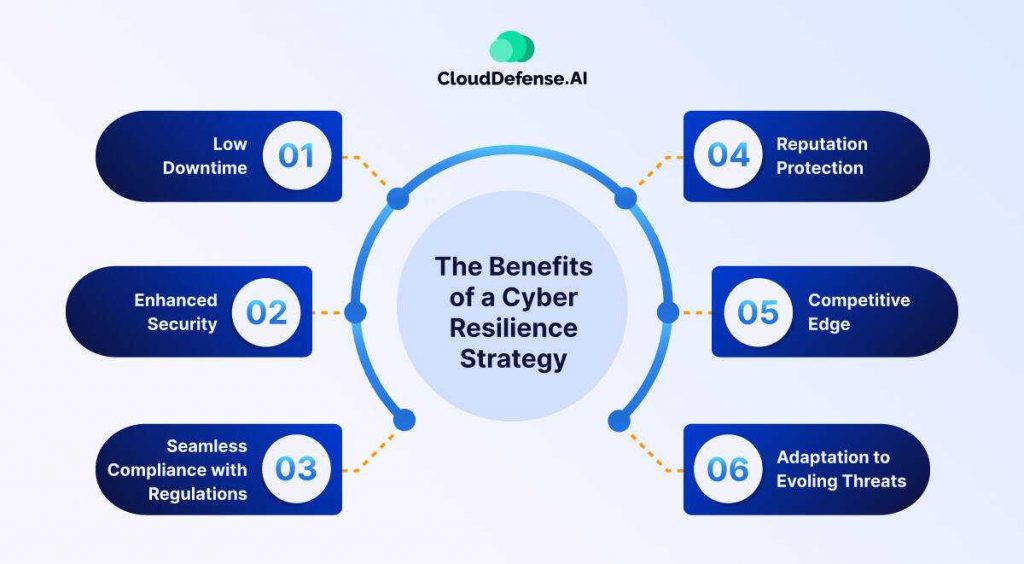Cybercrimes pose a major threat to businesses, with thousands occurring yearly. Organizations invest heavily in security but often still face attacks, disrupting operations and causing significant losses.
Developing a cyber resilience strategy is essential for safeguarding operations and managing risks. However, creating an effective strategy is challenging; it must not only prevent attacks but also enable quick recovery from breaches.
Here, we discuss 10 tips for building a cyber resilience strategy that protects your business from various attacks.
What is a Cyber Resilience Strategy?
A Cyber Resilience Strategy is a security approach that helps organizations prepare for, respond to, and recover from cyber threats while ensuring business continuity.
Unlike traditional cybersecurity, which focuses primarily on preventing attacks, cyber resilience acknowledges that breaches are inevitable and emphasizes the ability to withstand and recover from them with minimal disruption.
Key Components of a Cyber Resilience Strategy:

- Risk Assessment & Threat Intelligence – Understanding vulnerabilities and monitoring evolving cyber threats.
- Robust Cybersecurity Measures – Implementing strong security controls such as firewalls, encryption, and access management.
- Incident Response Plan – A well-documented plan that outlines actions to take during a cyber incident.
- Business Continuity & Disaster Recovery – Ensuring critical operations can continue during and after an attack.
- Employee Awareness & Training – Educating staff on security best practices to reduce human error.
- Regular Testing & Improvement – Running simulations, penetration tests, and updating policies to adapt to new threats.
A strong cyber resilience strategy helps organizations mitigate financial, operational, and reputational damage, ensuring long-term stability in an increasingly digital world.
What’s the Difference between Cybersecurity and Cyber Resilience?
Cybersecurity and cyber resilience are often used interchangeably, but they serve distinct purposes in an organization’s defense against cyber threats. Let’s understand how to differentiate between the two terms!
What is Cybersecurity?
Cybersecurity focuses on implementing technical measures and strategies to protect an organization’s systems, networks, and data from cyber threats such as breaches, ransomware, and malware. It aims to prevent cyberattacks by strengthening defenses and minimizing vulnerabilities.
Read more about cybersecurity in our blog here.
Let’s now look into the key differentiators between the two concepts:
Key Differences Between Cybersecurity and Cyber Resilience
| Aspect | Cybersecurity | Cyber Resilience |
| Focus | Preventing cyber threats | Ensuring business continuity despite cyber threats |
| Threat Handling | Primarily external threats (e.g., hackers, malware) | Both external and internal threats (e.g., hackers, human error) |
| Approach | Defensive – aims to stop attacks before they happen | Adaptive – accepts that breaches can occur and prepares for recovery |
| Goal | Minimizing the chances of a cyberattack | Minimizing the impact of an attack if it happens |
| Scope | Security policies, firewalls, encryption, access control | Incident response, disaster recovery, employee awareness, crisis management |
Cybersecurity is considered a shield that protects an organization from cyberattacks, while cyber resilience serves as the strategy that ensures the organization can withstand and recover if an attack happens. A robust security posture requires both—prevention through cybersecurity and recovery through cyber resilience—to address cyber threats effectively.
Common Cyber Resilience Threats

Cyber resilience threats are varied and evolving, so every organization must be aware of them. Here are some common threats that have plagued organizations most of the time:
Cyber Criminals
Undoubtedly, cybercriminals are one of the significant threats to an organization’s cyber resilience strategy. They pose a constant danger, always seeking ways to penetrate cybersecurity and extort data. From launching DDoS and malware attacks to deploying ransomware, cybercriminals continually strive to breach an organization’s systems.
User Errors
User error, in addition to criminal activities by cybercriminals, poses a significant threat to an organization’s cyber resilience. Modern IT infrastructure and networks are highly complex, often resulting in various human errors that can lead to data loss and disruptions in business operations.
Non-existent Incident Response Planning
The incident response plan is a critical element of an organization’s cyber resilience strategy, as it provides a response blueprint during an attack. When an organization fails to maintain a documented cyber incident response plan, it diminishes its ability to respond effectively to cyber incidents and amplifies the impact of such attacks. The absence of an incident response plan ultimately undermines the cyber resilience strategy.
Lack of Backup System
The cyber resilience of an organization primarily depends on its backup strategy. To implement an effective cyber resilience plan, an organization must establish a reliable backup system to safeguard all its assets. Without a robust backup system, the entire strategy may be compromised, as it relies on the organization’s ability to restore assets following an attack.
Natural Calamity
Natural disasters pose a significant threat to an organization’s cyber resilience, as they can disrupt IT infrastructure and halt all processes, including firewalls. Events such as earthquakes, storms, and floods can severely damage both IT infrastructure and cyber resilience.
The Benefits of a Cyber Resilience Strategy

When you build a cyber resilience strategy for your business, it provides you with numerous benefits, and these perks are:
Low Downtime
In modern times, downtime in business operations for a certain period can lead to huge financial losses.
Cyber resilience strategies protect your business from facing huge downtime and ultimately save your business from staggering losses. According to Uptime’s 2022 reports, a huge number of companies have lost around $100,000 due to operation downtime caused by cyber attacks.
Enhanced Security
The most prominent perk of having a cyber resilience strategy is that it strengthens your organization’s overall cyber security and minimizes the chance of cyber threats. It not only reduces the impact of cyber attacks but also helps in discovering vulnerabilities and preparing for upcoming threats.
A cyber resilience plan involves risk management, cybersecurity best practices, IRP, and continuous monitoring, which helps organizations provide better protection.
Seamless Compliance with Regulations
Whether it is GDPR, HIPAA, or CCPA, organizations have to strictly consider the regulatory requirements while developing their cybersecurity strategies. Cyber resilience strategies have become highly instrumental for organizations as they help them cater to requirements and showcase commitment towards optimum data protection.
Reputation Protection
When you have a solid cyber resilience strategy in place, it will help you to protect your reputation in the industry.
Not only that, but it also helps you to demonstrate your organization’s commitment to digital asset protection. With an effective cyber resilience strategy, you can not only minimize the damage to your infrastructure but also build trust among customers and stakeholders.
Competitive Edge
With a robust cyber resilience strategy, you also get a competitive edge over your competitors and place your organization as a trusted and reliable entity. Not every company emphasizes cyber resilience; thus, it will help you position your organization as a trusted entity.
Adaptation to Evoling Threats
A cyber resilience strategy involves continuous improvement, and ultimately, helps you address evolving cyber threats. It serves as a crucial component of modern cybersecurity because it helps you stay ahead of the curve.
10 Tips for Building a Cyber Resilience Strategy
Establishing a cybersecurity resilience strategy is a challenging endeavor, and proper guidance is essential for its development. Here are the top 10 tips to help you create an effective strategy:
Create an Incident Response Plan
An essential recipe for a successful cyber resilience strategy is creating a well-documented incident response plan that indicates all the procedures to be followed during a cyber attack. The plan should cover all the procedures, methodologies, incident detection, and recovery processes. Importantly, the plan should be updated and tested at regular intervals to maintain effectiveness.
Emphasize Employee Training
Your organization’s employees play a crucial role in building and maintaining its cyber resilience strategy. You should conduct regular training for your employees and make them aware of all cybersecurity scenarios, best practices, and common threats. The training program should also cover how to identify threats and respond to them.
Conduct Regular Testing
Cyber threats are evolving over time, and no system is completely secure against modern attacks. Regularly testing and evaluating your security controls, methodologies, and practices will help you identify gaps that need to be addressed. You can conduct security audits, penetration tests, and vulnerability assessments for this purpose.
Assessing the Overall Security Posture
You should regularly assess your organization’s overall security posture because any vulnerability or risk can jeopardize the strategy. Various assessment processes can be implemented to evaluate this process, which will help develop a successful cyber resilience strategy.
Enforce Data Protection and Encryption
The protection of all sensitive information and business operations is the primary goal of every cyber resilience strategy. To ensure optimal protection, you should enforce various encryption and data protection procedures to safeguard stored and transmitted data. Implementing a data classification framework and access control is one of the best ways to uphold the safeguarding and confidentiality of sensitive data.
Implement Collaborative Efforts
Cyber resilience strategy requires a collaborative effort, and it is best to take input from experts while building the strategy. It would be a wise move to partner with different experts or firms that will help you improve your cyber resilience capabilities. Gaining new insights and knowledge from experts will help you make the right effort.
Employ Continuous Monitoring
It is vital to have real-time visibility into your business operations, processes, and network, and the best way to do this is by deploying continuous monitoring. You should leverage SEM tools, log analysis, and other methodologies to discover possible system vulnerabilities. Taking a proactive approach will help you build a cyber resilience strategy.
Build a Proper Recovery Strategy
Focusing on backup and recovery is important when building a cyber resilience strategy. You must develop an effective strategy for backing up and restoring data that will help you during a serious security breach. All data should be backed up regularly, and you should conduct tests to ensure that the data are effectively restored.
Continuously Improve
Cyber resilience is not a one-time process. To adapt to the latest cyber threats, you must regularly evaluate and improve your strategy. You must also implement cyber resilience best practices at regular intervals and continuously enhance your security posture to minimize the chance of an attack.
Stay Updated with the Latest Threats
To ensure an effective cyber resilience strategy, you must keep every team member updated on the latest cyber threats, cybersecurity trends, and compliance issues. To stay updated, you should participate regularly in webinars, follow cybersecurity blogs, and read the latest news.
FAQ
What is the primary goal of a cyber resilience strategy?
The primary goal of a cyber resilience strategy is to ensure the business operation can work effectively in a situation of cyber attack. It helps the organization to cope with known and unknown cyber threats and risks and recover from such situations.
What are the 4 pillars of cyber resilience?
The four pillars of cyber resilience are anticipating, withstanding, recovering, and adapting. The recovery aspect indicates the restoration of business operations after an attack. Anticipating shows that the organization is aware of possible threats.
Withstanding tells the organization has to take necessary measures to ensure business continuity in the face of adverse attacks. The adapt pillar indicates that the organization has to change functions and security controls to minimize the impact of attacks.
What are the three Rs of cyber resilience?
The three Rs of cyber resilience are resist, respond, and recover. Resist involves implementing effective measures to prevent cyberattacks, whereas respond demonstrates an organization’s Incident Response Plan (IRP) to address cyber incidents. Recover refers to the restoration of crucial data and the resumption of operations after an attack.
What is the cyber resilience lifecycle?
The cyber resilience lifecycle is essentially a framework that illustrates the different stages involved in sustaining cyber resilience within an organization. It encompasses stages such as strategy, design, transition, operation, and improvement.
Conclusion
When you decide to build a cyber resilience strategy for your organization, you will have to take a strategic approach to build it successfully. Our 10 tips for building a cyber resilience strategy will provide you with a practical guide that will help you quickly build and maintain resilience. In this article, we have covered all the necessary aspects you need to understand while building a resilience strategy.







